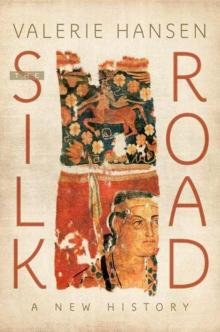- Home
- Valerie Hansen
The Silk Road: A New History Page 3
The Silk Road: A New History Read online
Page 3
It is clear, though, that Zhang went through Xiongnu territory on his way to the Yuezhi. The Xiongnu imprisoned Zhang, and it took him about ten years to escape. Nonetheless, he still proceeded to visit the Yuezhi. On his return, sometime around 126 BCE, he gave the emperor the first detailed information the Chinese received about the different peoples of Central Asia.20 Zhang Qian was extremely surprised to discover that Chinese merchants and trade goods had preceded him to Central Asia. In the markets of Bactria, in modern-day northern Afghanistan, Zhang Qian saw bamboo and cloth manufactured in the Chinese province of Sichuan, several thousand miles away. The Chinese goods must have traveled overland.
After Zhang Qian’s return, the Han dynasty gradually extended its control into the northwest. By the end of the second century BCE it secured the Gansu corridor and Dunhuang. Each time the Chinese army conquered a new region, it constructed beacon towers at fixed intervals. If a disturbance occurred, the soldiers guarding the beacon tower lit torches to alert the men in the next tower, and so on down the line until the news reached the first garrison that could dispatch troops to the troubled area. In addition to the beacon towers, the Han military also established garrisons in the newly conquered territories. Documents in the form of bamboo slips recording army purchases of clothing and grain from the local people have been found at Juyan (Ejina Banner, Inner Mongolia, 90 km northeast ofJinta County, Gansu) and Shule (near Dunhuang and Jiuquan, Gansu).21
The largest cache of early documents from the Silk Road was excavated from just such a Chinese garrison at Xuanquan, located 40 miles (64 kilometers) east of Dunhuang.22 A square dirt wall, 55 yards (50 meters) on each side, surrounded the complex, which had a stable for horses on its southern edge. Officials traveling on government business were entitled to get fresh mounts at the garrison, which also functioned as a postal station. On the northern and western edges of the enclosure were waste disposal areas; the western garbage pit extended 1.3 yards (1.2 m) underground at its greatest depth. The 2,650 artifacts from the site included coins, farm tools, weapons, iron cart parts, and utensils such as combs and chopsticks, as well as foodstuffs like grain, garlic, walnuts, almonds, and animal bones.23
There are more than 35,000 discarded documents from the Xuanquan site: 23,000 wooden slips with Chinese characters on them, and 12,000 bamboo slips trimmed to size, apparently intended for later use. About two thousand of the slips bear dates between 111 BCE and 107 CE, the years when the garrison was in use.
The slips are written on wood and bamboo because paper was just spreading to Central Asia at this time. Invented in China during the second century BCE, paper was first used as a wrapping material and not for writing. The official histories record, for example, that in 12 BCE a murderer used poison wrapped in paper.24 Some of the earliest paper scraps found at Xuanquan, dating to the first century BCE, also bear the names of medicines, confirming the early use of paper as a wrapping material.
Not until four centuries later, in the second century CE, did paper come into widespread use as writing material in China. It took even longer for paper to replace wood and bamboo as the most common writing material along the Silk Road. Because paper was always expensive, people wrote on other materials like leather and tree bark. The documents at Xuanquan consist mostly of wooden slips tied together to form bunches (much like a placemat made from Popsicle sticks).
The documents from the Xuanquan site include much everyday correspondence among the officials stationed at the Xuanquan postal station and other nearby locations, notices of new edicts issued by the emperor, announcements of runaway prisoners, and private letters. The scribes at Xuanquan distinguished among different types of wood: they reserved higher-quality pine for imperial edicts and used poplar and tamarisk, which warped easily, for routine documents and correspondence.
Since Xuanquan was the final stop before Dunhuang on the way out of China, almost all envoys passed through it once on their journey into Han-dynasty China and again when leaving. Chinese geographic sources from the Han dynasty list more than fifty kingdoms in Central Asia. Although the Chinese documents usually refer to these rulers as kings, each domain often consisted of a single oasis with a population as small as several hundred people and no larger than several thousand. These oases resembled small city-states more than kingdoms.25
DOCUMENTS BEFORE PAPER
Even after paper spread from China to the Silk Road in the second century BCE, some documents continued to be written on wooden slips. The earliest paper was used to wrap medicine, and it was not until the third century CE that the transition to using paper for writing was complete. These slips record the carts requisitioned by a garrison. Bound together by string, they were rolled up when stored. Characters were read in columns from top to bottom and from right to left, so one began reading at the upper right-hand corner, and read vertically down the first slip, returning to the top of the second slip, and continuing in the same way until finishing at the bottom left corner.
Big or small, these different states dispatched envoys to visit the Chinese capital to present gifts to the emperor, whom they acknowledged as their superior, and to receive gifts in return. Among the most treasured gifts were the horses that grazed in the Central Asian grasslands; because they roamed free, they were always stronger than the smaller, less powerful Chinese breeds that ate fodder hand-carried to their stables. The Chinese prized the heavenly horses of the Ferghana valley, in Uzbekistan, most of all. Even in this early period, during the Han dynasty, it is impossible to distinguish between official trade, in which an envoy brought a gift (often animals such as horses or camels) and received something for his ruler in return, and private trade, in which the same envoy might present an identical animal to the Chinese and keep the return gift for himself.
The gift-bearing delegations from Central Asian kingdoms varied in size. On some occasions delegations were a thousand strong: the king of Khotan, for example, headed a single group of 1714 people.26 More typical was a delegation from Sogdiana, in 52 BCE, that included two envoys, ten aristocrats, and an unspecified number of other followers, who led nine horses, thirty-one donkeys, twenty-five camels, and a cow.27
These delegations traveled on fixed itineraries and carried travel passes listing the towns, in order, they were allowed to visit. According to the law of the Han dynasty, which drew on even earlier precedents, anyone going through a checkpoint, on land or by water, needed a travel pass, called a guosuo (literally “passing through a place”).28
Several of the Xuanquan documents list all the stops between Dunhuang, the first town within the empire, and the Han-dynasty capital, either Chang’an in the first century BCE or Luoyang in the first century CE. Delegations were not permitted to stray from these routes. At each stop, officials counted the people in each delegation and the animals traveling with them to ensure that the party exactly matched the one enumerated on the travel pass. Officials could emend these passes and could also issue new passes. They checked the delegations when they went through Xuanquan on their way to China and again when they left Xuanquan, usually about six months later, on their way back to Central Asia. The cooks at Xuanquan kept detailed records of their expenditures on food for each guest, whether Chinese or foreign, whom they identified by rank and direction of travel (east or west).29
The wooden slips from Xuanquan are remarkably detailed. One of the longest records describes a dispute occurring in 39 BCE, when four Sogdian envoys petitioned Chinese officials to protest the low prices they had received for camels. The Sogdians maintained that Chinese officials had paid them the rate for thin, yellow camels, but they had actually delivered more valuable fat, white camels. The Sogdian envoys not only had a clear sense of market values but also sufficient confidence in the predictability of the system to protest when the prices diverged from their expectations. The Sogdians also expected, as envoys carrying the appropriate credentials, to be housed and fed at each stop along the way, but ended up paying for their meals instead. The offici
als at Dunhuang who heard the dispute in 39 BCE concluded that the Sogdians had been appropriately compensated. One possible explanation for the harsh treatment of the envoys: the Han-dynasty officials bitterly resented the Sogdians for cooperating with their longtime enemy, the Xiongnu, so they retaliated by underpaying them.30
The Xuanquan documents define an entire world, a world that included oases on the far western edge of China, near the modern city of Kashgar, as well as those beyond modern China’s border in Uzbekistan, Pakistan, and Afghanistan. The rulers of these different Central Asian oases participated in the systematized exchange of diplomatic envoys with the Chinese emperor of the Han dynasty, and envoys from these different points regularly traveled the Silk Road on their way to the Chinese capital.
Of the many foreign embassies that visited the Han-dynasty emperors to present tribute, only one was conceivably from Rome. An envoy from the ruler of Da Qin (literally the “Great Qin”), the official history reports, arrived by sea in 166 CE. Da Qin sat on the western edge of the world known to the Chinese and displayed many characteristics of a utopia; only in some instances does the term refer specifically to Rome. The Da Qin emissary presented ivory and rhinoceros horn, typical products of Southeast Asia. Many suspect that this envoy was an imposter who claimed to be from a distant, barely known place in order to receive permission to trade. This single mention is intriguing but hardly conclusive.31
As the Xuanquan documents and other materials reveal, the Han dynasty initiated regular trade along the routes around the Taklamakan for purely strategic reasons—they sought alternative routes to Central Asia so that they could bypass the Xiongnu, their constant enemy. Official envoys might occasionally engage in private trade, but always as a sideline to their official business. Their movements were never spontaneous but took place along carefully planned and recorded itineraries. For all their detail about Chinese trade with the Central Asian oases, the Xuanquan documents make no mention of any place west of the Kushan Empire (in northern Afghanistan and Pakistan) and certainly not of Rome itself.
Unfortunately, no documents with a level of detail comparable to the Xuanquan documents have been excavated on the European side, so analysis of Europe’s trade must rely on known Greek and Latin texts. One of the most informative sources is the Periplus of the Erythraean Sea, a book written sometime in the first century CE by an anonymous merchant living in Egypt who wrote in Greek.32 After describing the various ports of east Africa, Arabia, and India, the Periplus concludes with an account of the lands lying beyond the known world:
Beyond this region [an island in the sea to the east of the port at the mouth of the Ganges], by now at the northernmost point, where the sea ends somewhere on the outer fringe, there is a very great inland city called Thina from which silk floss, yarn, and cloth are shipped by land … and via the Ganges River.… It is not easy to get to this Thina; for rarely do people come from it, and only a few.33
Thina? The spelling makes sense, given that ancient Greek had no letter for the sound “ch” and the letter theta was probably pronounced something like ts in ancient Greek. The author did his best to record the unfamiliar name he heard from Indian traders. In Sanskrit, China was pronounced Chee-na (named for the Qin dynasty, 221–207 BCE); the Sanskrit word is the source of the English word “China.” In subsequent centuries, Roman geographers like Ptolemy (ca. 100–170 CE) learned more about Central Asia, but scholars are still struggling to reconcile their descriptions with the actual geography of the region.34 The author of the Periplus is certain of only one kernel of information about the Chinese: they produced silk in the form of floss from cocoons, spun thread from that floss, and wove cloth from the thread.
The Chinese were indeed the first people in the world to make silk, possibly as early as 4000 BCE, if an ivory carving with a silkworm motif on it, from the Hemudu site in Zhejiang, constitutes proof of silk manufacture. According to the Hangzhou Silk Museum, the earliest excavated fragment of silk dates to 3650 BCE and is from Henan Province in central China.35 Skeptical of such an early date, experts outside of China believe the earliest examples of silk date to 2850–2650 BCE, the time of the Liangzhu culture (3310–2250 BCE) in the lower Yangzi valley.36
In the first century CE, when the Periplus was written, the Romans did not know how silk was made. Pliny the Elder (CE 23–79) reported that silk cloth had made its way to Rome by the first century. Pliny misunderstood silk production: he thought silk was made from a “white down that adheres to … leaves,” which the people of Seres combed off and made into thread. (His description more accurately describes cotton.) Yet in another passage he wrote about silkworms.37 Modern interpreters often translate Seres as China, but, to the Romans, it was actually an unknown land on the northern edge of the world.
China was not the only manufacturer of silk in Pliny’s day. As early as 2500 BCE, the ancient Indians wove silk from the wild silk moth, a different species of silkworm than the one the Chinese had domesticated. In contrast, the Indians collected broken cocoons that remained after the silk worms had matured into moths, broken through their cocoons, and flown away.38 Similarly, in antiquity, the Greek island of Cos in the eastern Aegean produced Coan silk, which was also spun from the broken cocoons of wild silk moths. Early on, the Chinese had learned to boil the cocoons, which killed the silk worms, leaving the cocoons intact and allowing the thread to be removed in long, continuous strands. Even so, Chinese silk cannot always be distinguished from wild silk, and it is possible that Pliny may have described Indian or Coan, not Chinese, silk.39
Because Chinese and Coan silk resemble each other so closely, analysts must identify motifs unique to China in order to determine the origins of a piece of silk. Yet since any motif can be copied, the most reliable indicator of Chinese manufacture is the presence of Chinese characters, which only the Chinese wove into their cloth. Textiles found in Palmyra, Syria, from the first to third centuries CE were among the earliest Chinese silks to reach west Asia from China.40 The Chinese emperor routinely sent envoys to the Western Regions to bestow textiles on local rulers, and they in turn probably sent them further west.
Still, most of the beautiful silks found in Europe that are labeled “Chinese” were actually woven in the Byzantine Empire (476–1453 CE). One scholar who examined a thousand examples dating between the seventh and thirteenth century found only one made in China.41
Silk in particular drew Pliny’s ire because he simply could not understand why the Romans imported fabric that left so much of the female body exposed: “So manifold is the labor employed, and so distant is the region of the globe drawn upon, to enable the Roman matron to flaunt transparent raiment in public.”42 He railed against other imported goods as well—frankincense, amber, and tortoiseshell, among others—because consuming them, in his opinion, weakened Rome.43
Had the trade between China and Rome been as significant as Pliny contended, some Roman coins would presumably have been found in China. Yet the earliest European coins unearthed in China are from Byzantium, not Rome, and date to the 530s and 540s.44 Vague rumors to the contrary, not a single Roman coin has turned up in China—in contrast to the thousands of Roman gold and silver coins excavated on the south Indian coast, where Roman traders often journeyed.45 Historians sometimes argue that coins made from precious metals could have circulated between two places in a given period but might not survive today because they were melted down. But the survival of so many later non-Chinese coins in China undercuts this argument. Many Iranian coins made of silver and minted by the Sasanian Empire (224–651) have appeared in quantities as large as several hundred (see the example in plate 4B).
In sum, the absence of archeological or textual evidence suggests surprisingly little contact between ancient Rome and the Han dynasty. Although Pliny the Elder offered a confident critique of the silk trade, no one in the first century CE collected any reliable statistics about Rome’s balance of trade.46 If Romans had bought Chinese silk with Roman coins, some remnants o
f Chinese silk might have surfaced in Rome. Starting in the second and third centuries, a few goods managed to make their way between Rome and China. This is the period of the Palmyra silks and also when Romans began to pin down the location of Seres.
The art-historical record in China also confirms intermittent contacts between Rome and China that accelerate in the second and third centuries CE. In the Han dynasty, only a few rare examples of Chinese art display foreign motifs. But by the Tang dynasty much more Chinese art incorporated Persian, Indian, and even Greco-Roman motifs.47 The Tang dynasty marked the high point of Chinese influence in Central Asia and also the height of the Silk Road trade.
This book starts with the first perceptible contacts between China and the West in the second and third centuries CE and concludes in the early eleventh century, the time of the latest excavated documents from Dunhuang and Khotan. Proceeding in chronological order, each chapter examines a different Silk Road site, chosen for its documentary finds. Niya, Kucha, Turfan, Dunhuang, and Khotan are in northwest China. Samarkand lies in Uzbekistan, while the nearby site of Mount Mugh is located just across the border in modern Tajikistan. The seventh, Chang’an, the capital of the Tang dynasty, is in Shaanxi Province in central China.
Chapter 1 begins with the sites of Niya and Loulan, because they have produced extensive documentary evidence of the first sustained cultural contacts among the local peoples, the Chinese, and a group of migrants from the Gandhara region of modern-day Afghanistan and Pakistan. These migrants introduced their own script and imported a technology for keeping written records on wood; they were also among the first Buddhists to enter the Western Regions. Even though Buddhist regulations, or vinaya, prescribed celibacy for monks and nuns, many of these Buddhists at Niya married, had children, and lived with their families, not in celibate monastic communities, as is so often thought.

 Military K-9 Unit Christmas: Christmas Escape ; Yuletide Target
Military K-9 Unit Christmas: Christmas Escape ; Yuletide Target Marked For Revenge (Emergency Responders Book 2)
Marked For Revenge (Emergency Responders Book 2) Canyon Standoff
Canyon Standoff Trail of Danger
Trail of Danger A Puppy's Tale
A Puppy's Tale Marked for Revenge
Marked for Revenge Fatal Threat
Fatal Threat Christmas Vendetta
Christmas Vendetta Dangerous Legacy
Dangerous Legacy Blessings of the Heart
Blessings of the Heart Montana Reunion
Montana Reunion Her Montana Cowboy
Her Montana Cowboy Wilderness Courtship
Wilderness Courtship Rookie K-9 Unit Christmas
Rookie K-9 Unit Christmas Rescuing the Heiress
Rescuing the Heiress The Danger Within
The Danger Within Family in Hiding
Family in Hiding Love Inspired December 2013 - Bundle 2 of 2: Cozy ChristmasHer Holiday HeroJingle Bell Romance
Love Inspired December 2013 - Bundle 2 of 2: Cozy ChristmasHer Holiday HeroJingle Bell Romance The Silk Road: A New History
The Silk Road: A New History Search and Rescue
Search and Rescue Standing Guard
Standing Guard Small Town Justice
Small Town Justice Explosive Secrets (Texas K-9 Unit)
Explosive Secrets (Texas K-9 Unit) Threat of Darkness
Threat of Darkness Bound by Duty
Bound by Duty The Hamilton Heir
The Hamilton Heir Face of Danger
Face of Danger The Troublesome Angel
The Troublesome Angel Healing the Boss’s Heart
Healing the Boss’s Heart Deadly Payoff
Deadly Payoff Samantha's Gift
Samantha's Gift Her Cherokee Groom
Her Cherokee Groom Everlasting Love
Everlasting Love The Perfect Couple
The Perfect Couple Blessings of the Heart and Samantha's Gift
Blessings of the Heart and Samantha's Gift Nightwatch
Nightwatch Nowhere to Run
Nowhere to Run The Doctor's Newfound Family
The Doctor's Newfound Family The Rookie's Assignment
The Rookie's Assignment Frontier Courtship
Frontier Courtship Out of the Depths
Out of the Depths Special Agent
Special Agent Hidden in the Wall
Hidden in the Wall